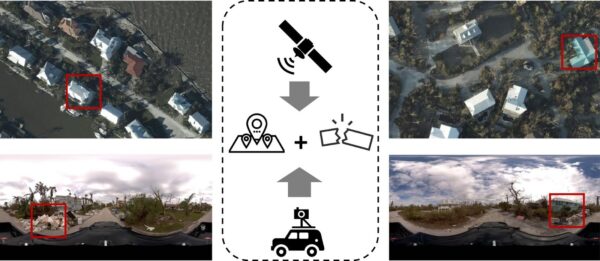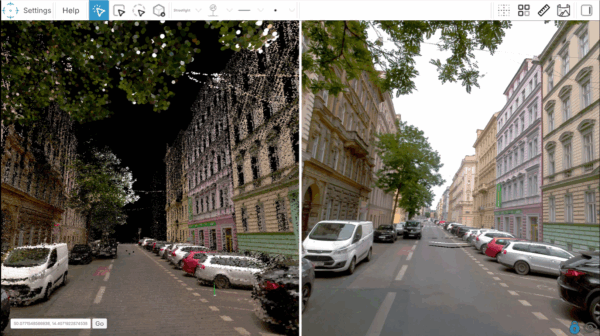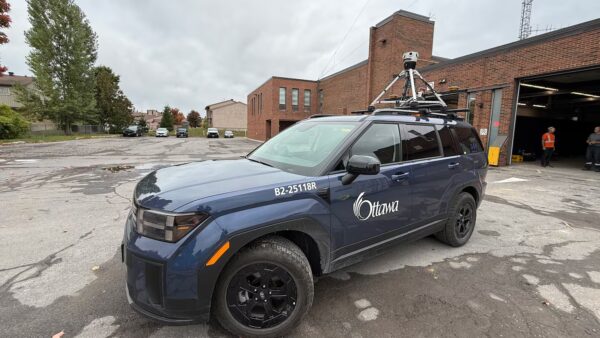Collecting telecom infrastructure assets and performing site surveys at a fraction of the time and costs. Learn how mobile mapping for telcos with high-resolution imagery is solving problems.
Automated Telecom Asset Inspections with 360º Cameras
The telecom industry is one of the largest and furthest-reaching in the world. So costs and efficient management of time and resources are paramount. Let’s dive into what is involved in telecommunication asset monitoring and infrastructure surveying, and where there is potential to do this better.
‘Telecommunication is the most competitive and fastest-growing market in the world.’
Telecommunications at its core
The definition of telecommunications is communicating over a distance, not a definition we often think about, as we likely take it for granted. The industry consists of internet service providers, satellite, cable, and telephone companies.
These telecom companies provide us with a network to exchange information electronically. Through the use of the internet, Ethernet, radio, and perhaps the lesser familiar public switched and packet switched networks.
There is no doubt that the telecoms industry is huge. It is growing, profitable, and highly competitive.
The global telecom market size is expected to grow from $2,642.14 billion in 2021 to $2,866.61 billion in 2022 at a compound annual growth rate of 8.5%.
The telecoms market is expected to reach $3,818.36 billion in 2026 at a compound growth rate of 7.4%.
The Business Research Company
The average net profit for telecom companies, as of 2022, is 12.5%. Gross profit margins for telecoms can be as high as 70-80% – but much of this is lost to incredibly high overhead expenses, such as research and development. So companies are always looking for ways to lower costs and increase margins.
Telecommunications is highly capital-intensive. It requires large and continuous investment to produce good service and to stay afloat in a competitive market.
How has it grown?
Telecommunications has changed industries such as education, medicine, and e-governance, and contributed substantially to economic growth on a global scale.
In the past few years, the telecoms industry has experienced a core shift in the arrival of wireless communication. The internet has all but killed traditional phone calls, and picking up the phone is no longer the predominant means of communication for businesses and individuals.
This isn’t a bad thing. Less anxiety is born from an unexpected call from your mother and has been all but replaced by message notifications that you can blissfully ignore.
Competition plays an enormous part.
A highly dynamic and technology-driven sector, telecommunications has been racing forward in leaps and bounds since the 1990s.
In countries worldwide, it has been found that competition played a central role in the growth and expansion of telecommunications.
The main source of competition for telecom operators is the size of their customer base. The key factors they must maintain for customer satisfaction are as below:
- Communication and Coverage
- VAS
- Price and Tariff Structure
- Convenience
- Customer Service
- Sales Promotion
Price and quality of customer service are easily regulated. When competing companies arise, larger and market-prominent companies can lower costs to become more accessible to the general public.
As well as this, larger telecom companies are looking to discover fresh tech to appeal to a wider consumer base. This is done by offering new products and packages to keep customer satisfaction high and ensure the company’s place at the top of the list.
Technology plays a big part in the very start of the telecommunications process too, taking us back to the initial comparison – how does reality 360º imaging affect the telecoms industry?
The Telecom Infrastructure Set-Up
For telephone lines, cabling, and internet wiring to be set up, the land first needs to be surveyed.
A telecommunications surveyor works on the ground level to identify new locations to expand a network. In this process, they will check the following for a new site:
- Establishing area zones and boundaries (Right of Way)
- Identify network locations
- Identify road type and surface
- Check for health and safety hazards
- Collect and assess topographical data
- Note any other installed utility lines
The process needs to be streamlined and efficient, and the data collected needs to be of high quality. This is where cutting-edge tech matters.
The industry is progressing and incorporating improved methods into its original processes. Particularly now, when artificial intelligence and machine learning algorithms are proving to be highly effective.
Mobile Mapping Provides Automated Telecom Site Surveying
It’s hard to believe it, but many companies in 2022 are still conducting site surveying for telecom (and utility) companies in the same manner that they did 50 years ago – manually! It’s still common that workers go pole to pole, visually inspecting the poles, wires, as well as other assets and surrounding areas, called “Right Of Way”. And very often they are recording all of this with paper and pen.
Many telecommunication service providers have been looking to upgrade their technologies for data collection, but have been facing other problems along the way.
So whether they stuck to the old ways or tried to innovate to the most modern and technologically advanced methods, they faced many challenges.
Cost and Resources – How Telecom Site Surveying Techniques Weren’t Making the Cut
Cost was a big issue. Using old techniques meant a lot of man-hours on the ground. Repeated site visits and long drives to rural areas to look at one small detail.
Even hiring mapping companies to do the job for you, the price can still be quite high.
Resources were another main issue, with initial surveyors themselves collecting the data, then, as technology progressed, sourcing other companies to provide this service. This is a laborious task, taking senior surveying and GIS technicians and engineers away from (what should be) their main task, to spend time collecting data.
Access to the data. In our modern world, we need to communicate with colleagues, partners, and customers from all over the world. For companies who continue to use outdated techniques (pen and paper) this does not translated well when needed to share details with coworkers in another office or with a partners who wants to know what is happening.
Quality of the data. Yet another issue was that once the data was collected, it was simply not of high enough quality to be accurately and efficiently assessed. What surveyors needed was accurate, sharp, 360º imagery for their telecom clients, provided by equipment that would adhere to the below:
- Provide high-quality imagery
- Physically manageable
- User friendly
- Hardwearing and robust
- Speed – fast data collection
- Reliable
- Cost-effective
The Solution – a Standalone Mobile Mapping Camera
Mobile mapping is a form of capturing data from a mobile vehicle or device. A vehicle is equipped with cameras to capture photo-realistic 360º imagery, and sensors that record the positioning location
For an efficient and streamlined data collection, a lightweight model manageable by a single person is ideal. A system with built-in processors and a camera that can capture high-resolution, realistic 360º imaging.
Enter the Mosaic 51.
Let’s see how this camera not only meets but surpasses all of those requirements above!
High-Quality Imagery
Mosaic 51 is installed with six 12-megapixel lenses that capture sharp, high-quality, realistic 360º imagery. Surveyors can capture HD-quality street-level images of telecom site locations to accurately assess for inspection and expansion.
Road features such as type and surface are captured, and hazards such as cracks, potholes, and surface deterioration are identified. Power lines, telephone poles, and road signs are all photographed and stored quickly and easily.
Physically Manageable
Weighing only 4.5kg, a single person can easily lift and affix this camera to a car roof.
User Friendly
Minimal training is required for this AI-compatible standalone unit. It is easy to manage and straightforward to use.
There are no bulky additional hard drives required, as the GPU and CPU systems are entirely built in, along with large internal storage. It’s a compact, user-friendly system.
Hardwearing and Robust
The model itself is a hardy structure, able to withstand water, heat, dust, and dropping temperatures. The same applies to the industrial frame and all connectors. The camera lenses have protected optics, and the noise-free image sensors have thermal management.
Speed
Mobile mapping units can capture data while driving at the speed of traffic. This means the driver can collect the necessary data from the comfort and safety of his/her own vehicle in seconds, rather than a ground crew spending hours on one site visit.
Reliability
A solid piece of tech, data is collected swiftly and easily. The camera is a well-designed piece of equipment and easy to use, allowing surveyors to collect data on schedule and ensuring client deadlines are met.
Cost Effective
Competitively priced in the market, the Mosaic 51 is not only a financially viable upfront option, but due to its efficiency and capabilities, the potential for recurrent costs is reduced considerably.
A model that is installed, driven, and operated by one person saves time and resources, saving surveyors and telecom companies considerable money long term.
Following data collection, the surveying technicians can use the documented digital and precisely synchronized timestamped datasets to make the necessary decisions.
Let’s hear it from Catsurveys – a leading surveying company in the UK that specializes in, among other sectors, telecommunications, and has had recent experience using the Mosaic 51:
Our approach with your camera, an absolute winner.
We were able to move the price point of individuals down somewhere in the region of 40%, being able to work like this……quite an attractive proposition…..
That’s enabled us to stay competitive. With our client, it hasn’t cost us more, and they’re not paying anymore. They have a much better outcome, and more importantly the pace. We can cover somewhere in the region of 3,500 homes in a day. Contrasted with one surveyor, capturing images, can cover about 200 homes per day.
Dan Davis, Head of Delivery at CatSurveys
Read more about the success of Catsurveys with the Mosaic 51 here.
The Future of Telecoms
New challenges and opportunities arise in any sector, and telecommunications is no different. Companies are forced to integrate with fresh technology or reinvent for fear of dropping in the market.
The recent pandemic has only encouraged this further, with the use of digital communication now higher than ever. 5G networks, Big Data, IoT – the importance and integration of each are growing substantially.
In the future, telecommunications will see more competition as technology advances to encompass artificial intelligence, machine learning, neural networks, and blockchain.
Fiber Optic
One of the biggest trends in 2022 is fiber optic deployment. As we know, telecom companies are using surveyors to assess how they can continue expanding their networks. Fiber optics can provide the expectations and needs of customers, and it is forecasted that more fiber will be deployed in the next five years than all fiber optics deployed to date.
There are 3 billion internet users in the world.
Each of these is looking for faster speeds, reliable connectivity, and likely soon 5G networks. By the end of 2022, connections to 5G will reach over 1.3 billion.
Optic fiber deployment will provide widespread access to high-speed internet.
When every community can leverage fiber optics for its critical infrastructure, we’ll open endless possibilities for prosperity
Gary Bolton, President and CEO – The Fiber Broadband Association
Machine Learning
Optimizing and streamlining processes is a sure way to stay ahead of competitors.
Keeping costs effective in surveying allows companies to invest in innovative technology. Integrating artificial intelligence and machine learning in collecting data will improve business margins further.
AI and machine-learned software that can identify road signs and recognize lettering for street names and building facades, whilst collecting data, saves time and resources.
Algorithms can anticipate issues in maintenance, for example, and telecom companies can take action on these before they adversely affect the customer.
Blockchain
The global blockchain in telecom market is expected to grow at a CAGR of 77.9% during 2022 to 2030, reaching $1.37 billion by 2024
Report Ocean Research
Blockchain is considered to simplify day-to-day operations in telecoms processes. It has positioned itself within the market as a future trend, namely, enhancing information and transaction security.
This is especially relevant for the IoT, with cyberattacks increasing yearly, linked devices are a tempting target full of sensitive information. In 2022, IoT manufacturers are developing multi-layered security strategies instead of relying on standard passwords.
Mobile Mapping for Telcos
The most successful telecommunication companies, with the highest profit margins, are those that establish a brand identity, maintain and expand the customer base, manage their capital, and stay up to date on cutting-edge technology.
The collection and assessment of realistic 360º imagery with a mobile mapping solution is top of the list when scoping new locations for expansion, and it is this technology that companies will need to use to stay competitive.
If you are looking for a solution that enables mobile mapping for telcos, then reach out to the Mosaic team below, and let’s find you the tool that can solve your problems.











